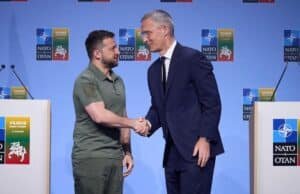
Up until this point: What does NATO think about Ukraine joining? Despite being heavily embroiled in the Russia-Ukraine conflict, the North Atlantic Treaty Organization (NATO) attempted to present a united front during its two-day summit in Vilnius, Lithuania, on July 11 and 12. Turkey, NATO's second-largest military power behind the United States, dropped its objection to Sweden joining the alliance just before the meeting got underway. Additionally, the summit established new spending targets for participants and made a long-term support promise to Ukraine. The promise of Ukraine's membership in the alliance, however, on which there was no clarity or time period, was the one subject that cast a shadow over the Vilnius summit.
At the Bucharest summit in 2008, NATO extended an invitation to Ukraine and Georgia, two nations in the Black Sea basin that border Russia on land. Both nations “will join NATO,” the alliance declared at the time. Volodymyr Zelenskyy, the president of Ukraine, wanted a more specific commitment from NATO for the membership of his country fifteen years later, ahead of the Vilnius summit. The Vilnius communiqué, however, declared that “when allies agree and conditions are met, we will be in a position to extend an invitation to Ukraine to join the alliance.”
Therefore, Ukraine hasn’t made much progress in joining NATO over the past 15 years. However, when the opportunity for membership arose in 2008, a number of nations, including France and Germany, opposed Ukraine joining the coalition out of concern that doing so would irritate Russia. However, there has been a noticeable change in that more member nations now support the concept of Ukraine joining NATO in the midst of Russia’s ongoing invasion of that country. The Ukraine-NATO Council would be used to continue Ukraine’s collaboration with NATO. The leading industrialized economies of the Group of Seven (G-7) have promised to bolster Ukraine’s weakened defense system by offering military training and institutional support for gaining NATO membership.
Prior to the conference, Germany unveiled a fresh military aid package, France pledged to provide its SCALP long-range missiles to Ukraine, and other NATO members committed to providing combat aviation training. Ukraine may not have a time schedule for membership, but it does have guarantees from NATO countries about military supply.
NATO stands for the North Atlantic Treaty Organization. It is an intergovernmental military alliance formed by North American and European countries to promote collective defense and security cooperation. NATO was established on April 4, 1949, with the signing of the North Atlantic Treaty. What does NATO think about Ukraine https://puneprime.news/bjp-claims-nda-has-support-of-38-parties-will-attend-big-meet-tomorrow/
Here are some key points about NATO: What does NATO think about Ukraine joining?
- Member Countries: NATO consists of 30 member countries, primarily from North America and Europe. The founding members include the United States, Canada, and several European nations. Over time, additional countries, including former Eastern Bloc nations, have joined NATO.
- Collective Defense: The principle of collective defense is at the core of NATO’s mission. According to Article 5 of the North Atlantic Treaty, an attack on one member country is considered an attack on all, and the member countries are obliged to respond collectively in the event of aggression.
- Security Cooperation: NATO engages in various activities to enhance security cooperation among member countries. These include joint military exercises, intelligence sharing, defense planning, and interoperability efforts to ensure that member nations’ armed forces can effectively operate together.
- Decision-Making: NATO operates on the basis of consensus decision-making, meaning that all member countries must agree on major policy decisions. The North Atlantic Council, which consists of representatives from each member country, is the principal political decision-making body within NATO.
- Partnerships: NATO has developed partnerships with other countries and organizations worldwide to promote dialogue, cooperation, and security. These partnerships include the Partnership for Peace program, Mediterranean Dialogue, Istanbul Cooperation Initiative, and others.
- NATO’s Role: NATO’s primary purpose is to deter aggression and ensure the collective defense of its member countries. However, the alliance’s role has evolved over time to address new security challenges, including counterterrorism, cybersecurity, and crisis management.
- Operations and Missions: NATO has conducted various military operations and missions, both within and beyond the alliance’s territory. Notable examples include the NATO-led mission in Afghanistan (2003-2014), the NATO intervention in Libya (2011), and peacekeeping missions in the Balkans.
NATO has served as a pillar of transatlantic security and stability since its establishment. It continues to adapt to new security challenges and work towards promoting peace, stability, and cooperation among its member countries.

